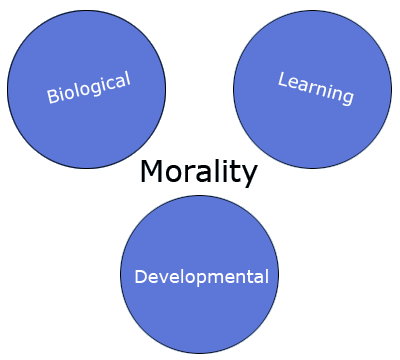Theories of Moral Development
Philosophers, psychologists and criminologists have all advanced various theories regarding the way(s) people become moral (or immoral). At the core are three basic theories: Biological, Learning, and Developmental. Biological theories attempt to explain development of moral behavior by seeking to discover biological characteristics that influence moral behavior. It has been determined that the frontal lobes of the brain influence an individual's capability for moral reason and compassion. Research has also determined that males are more prone to crimes of violence and are less inclined to demonstrate sympathy and understanding than do females. Biological criminology is but a single contribution to research on how biology influences moral development.Cesare Lombroso (1835-1909), physician and author of The Criminal Man (1876), has had great influence in biological theory. When performing autopsies he claimed to notice various physical characteristics and came to the conclusion that anyone possessing a certain number of these characteristics was a born or atavistic criminal.
Lombroso claimed that not all humans have evolved and that, in fact, some devolve or return to a brutish primitive or atavistic state. He stated that persons classed as atavistic were evolutionary throwbacks and born criminals who could be identified mainly by facial and head features such as head shape, pronounced noses, cheekbones and lips. His work lead to what became known as the science of phrenology.
An example of the influence of this pseudo-science can be found in Fowlers Self-Instructor in Phrenology (1889) . Fowler began his career as a traveling phrenologist "reading heads" in the Northeastern United States. In 1838, he opened what he termed a Phrenological Museum and not long afterwards began publication of the American Phrenological Journal. Although biological theory fell from favor during most of the 20th century, it has been making a gradual resurgence as medical science continues to unlock the secrets of human DNA.
Learning theory posits that moral development occurs as the result of the environment to which an individual is exposed. Modeling is a way in which others can be taught moral behavior. For example, children often mimic the behavior of their parents as well as mannerisms and beliefs. The same can also be said for other influential figures such as friends and prominent personalities.
Another aspect of learning theory is reinforcement. Moral or immoral behavior can be learned when a particular behavior, moral or immoral, receives positive or negative reinforcement. For example, a child who receives praise and adulation from their parents and/or other significant persons for good school performance is receiving positive reinforcement. Through positive reinforcement it is hoped that the child will enjoy the feeling of praise and will want that feeling repeated thereby creating a desire to continue to work hard in school. On the other hand, a person who commits crime and is subsequently found guilty and sentenced to a prison term is the recipient of negative reinforcement. The purpose of negative reinforcement is to persuade a person to cease engaging in a particular behavior. The foundation of the learning view can be traced to Gabriel Tarde. He stressed the concept of social learning by way of his three laws of imitation: close contact, imitation of superiors, insertion. The first two laws of imitation are used in Sutherland's theory of differential association. Burgess and Akers later expanded Sutherland's theory into social learning theory.
Cognitive dissonance theory postulates that there is a propensity for people to try to find consistency among their beliefs. When a contradiction occurs between attitudes or behaviors, dissonance is said to exist, and the person is propelled to remove the dissonance. In the event of an inconsistency between attitudes and behavior, it is highly probable that the attitude will be altered to adapt to the behavior, often accomplished through rationalization. For example, police officers are sworn to uphold the law, which includes the U.S. Constitution. Police officers who perform illegal searches or commit perjury must overcome their knowledge of violating the law they have sworn to uphold. Most often, this dissonance is wiped away with Noble Cause. In Noble Cause, police officers knowingly violate the law because they have substituted the belief to uphold the law with the belief to do what is necessary to get the job done.
Psychologists Jean Piaget and Lawrence Kohlberg endorse the view that moral development adheres to a corresponding path to physical, cognitive, and emotional development. They hold that humans develop through various phases of moral development from egocentrism to cooperativeness. People achieve greater levels of moral development as they acquire the capacity of abstract reasoning. The model developed by Kohlberg has three levels of moral reasoning: Preconventional, Conventional, and Post-Conventional. The Preconventional Level depicts moral reasoning prompted by worry for oneself. In the Conventional Level, moral reasoning is characterized as concerned with adhering to rules and executing one’s responsibilities linked with particular roles. The Post-Conventional Level depicts moral reasoning concentrated on shaping the universal good.
Those who stand opposed to Kohlberg claim that the levels center almost exclusively on the notion of justice and rules. They also note that his assertions are heavily dependent upon reason as the basis for moral development without taking emotion into consideration. Also, neither does it account for cultural differences in moral development, nor does it justify the disengagement between moral reasoning and behavior.
Gilligan called attention to the gender-influenced makeup of Kohlberg's research, in that he only studied young males. Gilligan noted in her research that she found a connection between a care perspective and females. She developed the concept of different morality for women and girls rather than understanding women's moral reasoning to be less developed than males.

